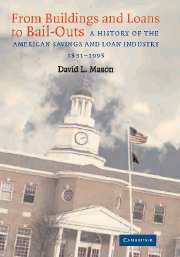 From Buildings and Loans to Bail-Outs
From Buildings and Loans to Bail-Outs Book contents
- Frontmatter
- Contents
- List of Tables
- Acknowledgments
- Introduction
- 1 A Movement Takes Shape, 1831–1899
- 2 The Rise of the League, 1900–1929
- 3 From State to Federal Oversight
- 4 The Movement Becomes an Industry, 1930–1945
- 5 The Glory Years, 1946–1955
- 6 External Challenges and Internal Divisions, 1956–1966
- 7 Lost Opportunities, 1967–1979
- 8 Deregulation and Disaster, 1979–1988
- 9 Resolving the Crisis, Restoring the Confidence, 1989–1995
- 10 The American Savings and Loan Industry in Perspective
- Appendices
- Bibliography
- Index
Introduction
Published online by Cambridge University Press: 29 October 2009
- Frontmatter
- Contents
- List of Tables
- Acknowledgments
- Introduction
- 1 A Movement Takes Shape, 1831–1899
- 2 The Rise of the League, 1900–1929
- 3 From State to Federal Oversight
- 4 The Movement Becomes an Industry, 1930–1945
- 5 The Glory Years, 1946–1955
- 6 External Challenges and Internal Divisions, 1956–1966
- 7 Lost Opportunities, 1967–1979
- 8 Deregulation and Disaster, 1979–1988
- 9 Resolving the Crisis, Restoring the Confidence, 1989–1995
- 10 The American Savings and Loan Industry in Perspective
- Appendices
- Bibliography
- Index
Summary
In his movie It's a Wonderful Life the director Frank Capra tells the story of George Bailey, the manager of the Bailey Bros. Building and Loan. This thrift association is in Bedford Falls, a small community where people know each other, families are stable, and personal morals are strong. Although the town also has a bank, most of the working-class residents belong to the local building and loan. A turning point in George's life comes on Christmas Eve when an audit reveals that $5,000 is missing from the thrift. George is unable to account for the funds, and after the banker Henry Potter accuses him of stealing the money, George panics and considers suicide. To prevent this, George's guardian angel Clarence lets him see what life in Bedford Falls would be like if he were never born, and by extension if his thrift did not exist. In a world without George and his building and loan, Potter controls the town and dominates the lives of its residents. Called Pottersville, the town is no longer peaceful and happy but a place where drinking, vice, and debauchery reign supreme. Most of the people rent apartments from Potter, have dysfunctional families, and generally regard each other warily. The experience makes George realize how important he and his work are to the community, which causes him to keep on living and face arrest for malfeasance.
- Type
- Chapter
- Information
- From Buildings and Loans to Bail-OutsA History of the American Savings and Loan Industry, 1831–1995, pp. 1 - 11Publisher: Cambridge University PressPrint publication year: 2004
